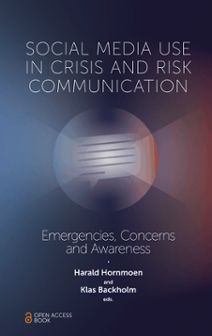
Index
Social Media Use in Crisis and Risk Communication
ISBN: 978-1-78756-272-1, eISBN: 978-1-78756-269-1
Publication date: 1 October 2018
Citation
(2018), "Index", Hornmoen, H. and Backholm, K. (Ed.) Social Media Use in Crisis and Risk Communication, Emerald Publishing Limited, Leeds, pp. 297-308. https://doi.org/10.1108/978-1-78756-269-120181001
Publisher
:Emerald Publishing Limited
Copyright © Harald Hornmoen and Klas Backholm
License
Except where otherwise noted, this work is licensed under a Creative Commons Attribution 4.0 Licence (CC BY 4.0). Anyone may reproduce, distribute, translate and create derivative works of this book (for both commercial and non-commercial purposes), subject to full attribution to the original publication and authors. The full terms of this licence may be seen at https://creativecommons.org/licenses/by/4.0/
INDEX
- Prelims
- Social Media Use in Crises and Risks: An Introduction to the Collection
- Part 1 Using Social Media in Risks and Crises
- Chapter 1 Tweeting Terror: An Analysis of the Norwegian Twitter-sphere during and in the Aftermath of the 22 July 2011 Terrorist Attack
- Chapter 2 Victims’ Use of Social Media during and after the Utøya Terror Attack: Fear, Resilience, Sorrow and Solidarity
- Chapter 3 Blood and Security during the Norway Attacks: Authorities’ Twitter Activity and Silence
- Chapter 4 Social Media in Management of the Terror Crisis in Norway: Experiences and Lessons Learned
- Chapter 5 News Workers’ Reflections on Digital Technology and Social Media after a Terror Event
- Chapter 6 Old Wine in New Bottles? Use of Twitter by Established UK News Media during the 2014–15 West African Ebola Outbreak
- Chapter 7 Flows of Water and Information: Reconstructing Online Communication During the 2013 European Floods in Austria
- Part 2 Developing a Tool for Crisis Communicators
- Chapter 8 Tailoring Tools to the Rescue: Lessons Learned from Developing a Social Media Information Gathering Tool
- Chapter 9 What Eye Movements and Facial Expressions Tell Us about User-Friendliness: Testing a Tool for Communicators and Journalists
- Part 3 Recommendations for Social Media Use in Risks and Crises
- Chapter 10 ‘When the Levee Breaks’: Recommendations for Social Media Use During Environmental Disasters
- Chapter 11 Social Media Communication During Disease Outbreaks: Findings and Recommendations
- Chapter 12 Social Media and Situation Awareness during Terrorist Attacks: Recommendations for Crisis Communication
- Index